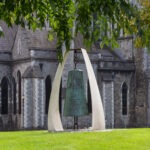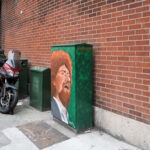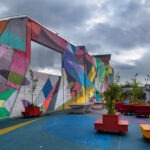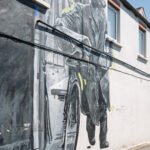THE STORY OF THREE UNRELATED BELLS
The “Liberty Bell” sculpture in St. Patrick’s Park, Dublin, is often a source of confusion due to its name and bell-like appearance. While it might be mistaken for a tribute to the American Liberty Bell, its history and symbolism are distinctly local. The sculpture, created by Vivienne Roche, is a modern piece that celebrates the Liberties area of Dublin, where the park is located. It is not, as I was once advised, related to the “Freedom Bell” cracked by Daniel O’Connell.
This brings us to the three bells mentioned already mentioned.
The Liberty Bell (USA): This is the iconic American bell, a symbol of American independence, known for its distinctive crack. It is located in Philadelphia and has no direct connection to the Dublin sculpture, other than the shared name and form.
The Bell at St. Patrick’s Park: This is the aforementioned sculpture by Vivienne Roche. It is a modern artwork that, despite its bell-like shape, is not a functional bell. It was created to celebrate the Liberties area, a historic and vibrant part of Dublin known for its working-class heritage and independent spirit. The sculpture’s design is intended to evoke the area’s history and character, rather than represent a specific historical event or object.
The Freedom Bell at Smock Alley: This is a separate, historical bell. Smock Alley Theatre, Dublin’s oldest theatre, has a bell that is said to have rung in celebration of the 1829 Catholic Emancipation Act, a key achievement of Daniel O’Connell’s campaign. While it is associated with O’Connell and the concept of freedom, the story of him physically cracking it is a myth. The bell is a historical artefact located within the theatre itself, not a public sculpture.
In summary, the artwork in St. Patrick’s Park is a contemporary piece by Vivienne Roche that celebrates the Liberties. It is not the American Liberty Bell, nor is it the historical “Freedom Bell” from Smock Alley Theatre, despite common misconceptions.

![THE LIBERTY BELL AT ST PATRICK'S PARK [THE STORY OF THREE UNRELATED BELLS]-255115-1](https://excellentstreetimages.com/HeadlessUrbanExpression/wp-content/uploads/2025/08/THE-LIBERTY-BELL-AT-ST-PATRICKS-PARK-THE-STORY-OF-THREE-UNRELATED-BELLS-255115-1-1422x1067.jpg)
![THE LIBERTY BELL AT ST PATRICK'S PARK [THE STORY OF THREE UNRELATED BELLS]-255114-1](https://excellentstreetimages.com/HeadlessUrbanExpression/wp-content/uploads/2025/08/THE-LIBERTY-BELL-AT-ST-PATRICKS-PARK-THE-STORY-OF-THREE-UNRELATED-BELLS-255114-1-1422x1067.jpg)
![THE LIBERTY BELL AT ST PATRICK'S PARK [THE STORY OF THREE UNRELATED BELLS]-255113-1](https://excellentstreetimages.com/HeadlessUrbanExpression/wp-content/uploads/2025/08/THE-LIBERTY-BELL-AT-ST-PATRICKS-PARK-THE-STORY-OF-THREE-UNRELATED-BELLS-255113-1-1422x1067.jpg)
![THE LIBERTY BELL AT ST PATRICK'S PARK [THE STORY OF THREE UNRELATED BELLS]-255112-1](https://excellentstreetimages.com/HeadlessUrbanExpression/wp-content/uploads/2025/08/THE-LIBERTY-BELL-AT-ST-PATRICKS-PARK-THE-STORY-OF-THREE-UNRELATED-BELLS-255112-1-1422x1067.jpg)
![THE LIBERTY BELL AT ST PATRICK'S PARK [THE STORY OF THREE UNRELATED BELLS]-255110-1](https://excellentstreetimages.com/HeadlessUrbanExpression/wp-content/uploads/2025/08/THE-LIBERTY-BELL-AT-ST-PATRICKS-PARK-THE-STORY-OF-THREE-UNRELATED-BELLS-255110-1-1422x1067.jpg)
![THE LIBERTY BELL AT ST PATRICK'S PARK [THE STORY OF THREE UNRELATED BELLS]-255111-1](https://excellentstreetimages.com/HeadlessUrbanExpression/wp-content/uploads/2025/08/THE-LIBERTY-BELL-AT-ST-PATRICKS-PARK-THE-STORY-OF-THREE-UNRELATED-BELLS-255111-1-1422x1067.jpg)
![THE LIBERTY BELL AT ST PATRICK'S PARK [THE STORY OF THREE UNRELATED BELLS]-255109-1](https://excellentstreetimages.com/HeadlessUrbanExpression/wp-content/uploads/2025/08/THE-LIBERTY-BELL-AT-ST-PATRICKS-PARK-THE-STORY-OF-THREE-UNRELATED-BELLS-255109-1-1422x1067.jpg)

![LUKE KELLY A NEW EXAMPLE OF STREET ART BY SAROSKY [PAINT-A-BOX STREET ART]-255011-1](https://excellentstreetimages.com/HeadlessUrbanExpression/wp-content/uploads/2025/08/LUKE-KELLY-A-NEW-EXAMPLE-OF-STREET-ART-BY-SAROSKY-PAINT-A-BOX-STREET-ART-255011-1-1420x1065.jpg)
![LUKE KELLY A NEW EXAMPLE OF STREET ART BY SAROSKY [PAINT-A-BOX STREET ART]-255010-1](https://excellentstreetimages.com/HeadlessUrbanExpression/wp-content/uploads/2025/08/LUKE-KELLY-A-NEW-EXAMPLE-OF-STREET-ART-BY-SAROSKY-PAINT-A-BOX-STREET-ART-255010-1-1420x1065.jpg)
![LUKE KELLY A NEW EXAMPLE OF STREET ART BY SAROSKY [PAINT-A-BOX STREET ART]-255009-1](https://excellentstreetimages.com/HeadlessUrbanExpression/wp-content/uploads/2025/08/LUKE-KELLY-A-NEW-EXAMPLE-OF-STREET-ART-BY-SAROSKY-PAINT-A-BOX-STREET-ART-255009-1-1420x1065.jpg)
![LUKE KELLY A NEW EXAMPLE OF STREET ART BY SAROSKY [PAINT-A-BOX STREET ART]-255008-1](https://excellentstreetimages.com/HeadlessUrbanExpression/wp-content/uploads/2025/08/LUKE-KELLY-A-NEW-EXAMPLE-OF-STREET-ART-BY-SAROSKY-PAINT-A-BOX-STREET-ART-255008-1-1420x1065.jpg)
![LUKE KELLY A NEW EXAMPLE OF STREET ART BY SAROSKY [PAINT-A-BOX STREET ART]-255007-1](https://excellentstreetimages.com/HeadlessUrbanExpression/wp-content/uploads/2025/08/LUKE-KELLY-A-NEW-EXAMPLE-OF-STREET-ART-BY-SAROSKY-PAINT-A-BOX-STREET-ART-255007-1-1420x1065.jpg)
![LUKE KELLY A NEW EXAMPLE OF STREET ART BY SAROSKY [PAINT-A-BOX STREET ART]-255005-1](https://excellentstreetimages.com/HeadlessUrbanExpression/wp-content/uploads/2025/08/LUKE-KELLY-A-NEW-EXAMPLE-OF-STREET-ART-BY-SAROSKY-PAINT-A-BOX-STREET-ART-255005-1-1420x1065.jpg)
![LUKE KELLY A NEW EXAMPLE OF STREET ART BY SAROSKY [PAINT-A-BOX STREET ART]-255006-1](https://excellentstreetimages.com/HeadlessUrbanExpression/wp-content/uploads/2025/08/LUKE-KELLY-A-NEW-EXAMPLE-OF-STREET-ART-BY-SAROSKY-PAINT-A-BOX-STREET-ART-255006-1-1420x1065.jpg)
![THE HIEROGLYPHS OF SUSSEX STREET [DUN LAOGHAIRE 3 JULY 2025]-253438-1](https://excellentstreetimages.com/HeadlessUrbanExpression/wp-content/uploads/2025/07/THE-HIEROGLYPHS-OF-SUSSEX-STREET-DUN-LAOGHAIRE-3-JULY-2025-253438-1-150x150.jpg)
![THE HIEROGLYPHS OF SUSSEX STREET [DUN LAOGHAIRE 3 JULY 2025]-253439-1 THE HIEROGLYPHS OF SUSSEX STREET [DUN LAOGHAIRE 3 JULY 2025]-253439-1](https://excellentstreetimages.com/HeadlessUrbanExpression/wp-content/uploads/2025/07/THE-HIEROGLYPHS-OF-SUSSEX-STREET-DUN-LAOGHAIRE-3-JULY-2025-253439-1-1422x1067.jpg)
![THE HIEROGLYPHS OF SUSSEX STREET [DUN LAOGHAIRE 3 JULY 2025]-253438-1 THE HIEROGLYPHS OF SUSSEX STREET [DUN LAOGHAIRE 3 JULY 2025]-253438-1](https://excellentstreetimages.com/HeadlessUrbanExpression/wp-content/uploads/2025/07/THE-HIEROGLYPHS-OF-SUSSEX-STREET-DUN-LAOGHAIRE-3-JULY-2025-253438-1-1422x1067.jpg)
![THE HIEROGLYPHS OF SUSSEX STREET [DUN LAOGHAIRE 3 JULY 2025]-253437-1 THE HIEROGLYPHS OF SUSSEX STREET [DUN LAOGHAIRE 3 JULY 2025]-253437-1](https://excellentstreetimages.com/HeadlessUrbanExpression/wp-content/uploads/2025/07/THE-HIEROGLYPHS-OF-SUSSEX-STREET-DUN-LAOGHAIRE-3-JULY-2025-253437-1-1422x1067.jpg)
![THE HIEROGLYPHS OF SUSSEX STREET [DUN LAOGHAIRE 3 JULY 2025]-253436-1 THE HIEROGLYPHS OF SUSSEX STREET [DUN LAOGHAIRE 3 JULY 2025]-253436-1](https://excellentstreetimages.com/HeadlessUrbanExpression/wp-content/uploads/2025/07/THE-HIEROGLYPHS-OF-SUSSEX-STREET-DUN-LAOGHAIRE-3-JULY-2025-253436-1-1422x1067.jpg)
![THE HIEROGLYPHS OF SUSSEX STREET [DUN LAOGHAIRE 3 JULY 2025]-253435-1 THE HIEROGLYPHS OF SUSSEX STREET [DUN LAOGHAIRE 3 JULY 2025]-253435-1](https://excellentstreetimages.com/HeadlessUrbanExpression/wp-content/uploads/2025/07/THE-HIEROGLYPHS-OF-SUSSEX-STREET-DUN-LAOGHAIRE-3-JULY-2025-253435-1-1422x1067.jpg)
![THE HIEROGLYPHS OF SUSSEX STREET [DUN LAOGHAIRE 3 JULY 2025]-253434-1 THE HIEROGLYPHS OF SUSSEX STREET [DUN LAOGHAIRE 3 JULY 2025]-253434-1](https://excellentstreetimages.com/HeadlessUrbanExpression/wp-content/uploads/2025/07/THE-HIEROGLYPHS-OF-SUSSEX-STREET-DUN-LAOGHAIRE-3-JULY-2025-253434-1-1422x1067.jpg)
![A GLIMPSE INTO THOMONDGATE'S PAST [A BLACK AND WHITE MURAL]-254073-1](https://excellentstreetimages.com/HeadlessUrbanExpression/wp-content/uploads/2025/07/A-GLIMPSE-INTO-THOMONDGATES-PAST-A-BLACK-AND-WHITE-MURAL-254073-1-150x150.jpg)
![A GLIMPSE INTO THOMONDGATE'S PAST [A BLACK AND WHITE MURAL]-254074-1 A GLIMPSE INTO THOMONDGATE'S PAST [A BLACK AND WHITE MURAL]-254074-1](https://excellentstreetimages.com/HeadlessUrbanExpression/wp-content/uploads/2025/07/A-GLIMPSE-INTO-THOMONDGATES-PAST-A-BLACK-AND-WHITE-MURAL-254074-1-1422x1067.jpg)
![A GLIMPSE INTO THOMONDGATE'S PAST [A BLACK AND WHITE MURAL]-254073-1 A GLIMPSE INTO THOMONDGATE'S PAST [A BLACK AND WHITE MURAL]-254073-1](https://excellentstreetimages.com/HeadlessUrbanExpression/wp-content/uploads/2025/07/A-GLIMPSE-INTO-THOMONDGATES-PAST-A-BLACK-AND-WHITE-MURAL-254073-1-1422x1067.jpg)
![A GLIMPSE INTO THOMONDGATE'S PAST [A BLACK AND WHITE MURAL]-254072-1 A GLIMPSE INTO THOMONDGATE'S PAST [A BLACK AND WHITE MURAL]-254072-1](https://excellentstreetimages.com/HeadlessUrbanExpression/wp-content/uploads/2025/07/A-GLIMPSE-INTO-THOMONDGATES-PAST-A-BLACK-AND-WHITE-MURAL-254072-1-1422x1067.jpg)
![A GLIMPSE INTO THOMONDGATE'S PAST [A BLACK AND WHITE MURAL]-254071-1 A GLIMPSE INTO THOMONDGATE'S PAST [A BLACK AND WHITE MURAL]-254071-1](https://excellentstreetimages.com/HeadlessUrbanExpression/wp-content/uploads/2025/07/A-GLIMPSE-INTO-THOMONDGATES-PAST-A-BLACK-AND-WHITE-MURAL-254071-1-1422x1067.jpg)
![A GLIMPSE INTO THOMONDGATE'S PAST [A BLACK AND WHITE MURAL]-254070-1 A GLIMPSE INTO THOMONDGATE'S PAST [A BLACK AND WHITE MURAL]-254070-1](https://excellentstreetimages.com/HeadlessUrbanExpression/wp-content/uploads/2025/07/A-GLIMPSE-INTO-THOMONDGATES-PAST-A-BLACK-AND-WHITE-MURAL-254070-1-1422x1067.jpg)
![A GLIMPSE INTO THOMONDGATE'S PAST [A BLACK AND WHITE MURAL]-254069-1 A GLIMPSE INTO THOMONDGATE'S PAST [A BLACK AND WHITE MURAL]-254069-1](https://excellentstreetimages.com/HeadlessUrbanExpression/wp-content/uploads/2025/07/A-GLIMPSE-INTO-THOMONDGATES-PAST-A-BLACK-AND-WHITE-MURAL-254069-1-1422x1067.jpg)
![A GLIMPSE INTO THOMONDGATE'S PAST [A BLACK AND WHITE MURAL]-254067-1 A GLIMPSE INTO THOMONDGATE'S PAST [A BLACK AND WHITE MURAL]-254067-1](https://excellentstreetimages.com/HeadlessUrbanExpression/wp-content/uploads/2025/07/A-GLIMPSE-INTO-THOMONDGATES-PAST-A-BLACK-AND-WHITE-MURAL-254067-1-1422x1067.jpg)
![A GLIMPSE INTO THOMONDGATE'S PAST [A BLACK AND WHITE MURAL]-254068-1 A GLIMPSE INTO THOMONDGATE'S PAST [A BLACK AND WHITE MURAL]-254068-1](https://excellentstreetimages.com/HeadlessUrbanExpression/wp-content/uploads/2025/07/A-GLIMPSE-INTO-THOMONDGATES-PAST-A-BLACK-AND-WHITE-MURAL-254068-1-1422x1067.jpg)

![HONAN'S QUAY A CANVAS OF CONTRADICTIONS [CLOSE UP AND FAR AWAY]-254302-1](https://excellentstreetimages.com/HeadlessUrbanExpression/wp-content/uploads/2025/07/HONANS-QUAY-A-CANVAS-OF-CONTRADICTIONS-CLOSE-UP-AND-FAR-AWAY-254302-1-1422x1067.jpg)
![HONAN'S QUAY A CANVAS OF CONTRADICTIONS [CLOSE UP AND FAR AWAY]-254301-1](https://excellentstreetimages.com/HeadlessUrbanExpression/wp-content/uploads/2025/07/HONANS-QUAY-A-CANVAS-OF-CONTRADICTIONS-CLOSE-UP-AND-FAR-AWAY-254301-1-1422x1067.jpg)
![HONAN'S QUAY A CANVAS OF CONTRADICTIONS [CLOSE UP AND FAR AWAY]-254300-1](https://excellentstreetimages.com/HeadlessUrbanExpression/wp-content/uploads/2025/07/HONANS-QUAY-A-CANVAS-OF-CONTRADICTIONS-CLOSE-UP-AND-FAR-AWAY-254300-1-1422x1067.jpg)
![HONAN'S QUAY A CANVAS OF CONTRADICTIONS [CLOSE UP AND FAR AWAY]-254299-1](https://excellentstreetimages.com/HeadlessUrbanExpression/wp-content/uploads/2025/07/HONANS-QUAY-A-CANVAS-OF-CONTRADICTIONS-CLOSE-UP-AND-FAR-AWAY-254299-1-1422x1067.jpg)
![HONAN'S QUAY A CANVAS OF CONTRADICTIONS [CLOSE UP AND FAR AWAY]-254298-1](https://excellentstreetimages.com/HeadlessUrbanExpression/wp-content/uploads/2025/07/HONANS-QUAY-A-CANVAS-OF-CONTRADICTIONS-CLOSE-UP-AND-FAR-AWAY-254298-1-1422x1067.jpg)
![HONAN'S QUAY A CANVAS OF CONTRADICTIONS [CLOSE UP AND FAR AWAY]-254297-1](https://excellentstreetimages.com/HeadlessUrbanExpression/wp-content/uploads/2025/07/HONANS-QUAY-A-CANVAS-OF-CONTRADICTIONS-CLOSE-UP-AND-FAR-AWAY-254297-1-1422x1067.jpg)
![HONAN'S QUAY A CANVAS OF CONTRADICTIONS [CLOSE UP AND FAR AWAY]-254296-1](https://excellentstreetimages.com/HeadlessUrbanExpression/wp-content/uploads/2025/07/HONANS-QUAY-A-CANVAS-OF-CONTRADICTIONS-CLOSE-UP-AND-FAR-AWAY-254296-1-1422x1067.jpg)
![HONAN'S QUAY A CANVAS OF CONTRADICTIONS [CLOSE UP AND FAR AWAY]-254295-1](https://excellentstreetimages.com/HeadlessUrbanExpression/wp-content/uploads/2025/07/HONANS-QUAY-A-CANVAS-OF-CONTRADICTIONS-CLOSE-UP-AND-FAR-AWAY-254295-1-1422x1067.jpg)
![HONAN'S QUAY A CANVAS OF CONTRADICTIONS [CLOSE UP AND FAR AWAY]-254294-1](https://excellentstreetimages.com/HeadlessUrbanExpression/wp-content/uploads/2025/07/HONANS-QUAY-A-CANVAS-OF-CONTRADICTIONS-CLOSE-UP-AND-FAR-AWAY-254294-1-1422x1067.jpg)
![HONAN'S QUAY A CANVAS OF CONTRADICTIONS [CLOSE UP AND FAR AWAY]-254293-1](https://excellentstreetimages.com/HeadlessUrbanExpression/wp-content/uploads/2025/07/HONANS-QUAY-A-CANVAS-OF-CONTRADICTIONS-CLOSE-UP-AND-FAR-AWAY-254293-1-1422x1067.jpg)
![HONAN'S QUAY A CANVAS OF CONTRADICTIONS [CLOSE UP AND FAR AWAY]-254292-1](https://excellentstreetimages.com/HeadlessUrbanExpression/wp-content/uploads/2025/07/HONANS-QUAY-A-CANVAS-OF-CONTRADICTIONS-CLOSE-UP-AND-FAR-AWAY-254292-1-1422x1067.jpg)
![HONAN'S QUAY A CANVAS OF CONTRADICTIONS [CLOSE UP AND FAR AWAY]-254291-1](https://excellentstreetimages.com/HeadlessUrbanExpression/wp-content/uploads/2025/07/HONANS-QUAY-A-CANVAS-OF-CONTRADICTIONS-CLOSE-UP-AND-FAR-AWAY-254291-1-1422x1067.jpg)
![HONAN'S QUAY A CANVAS OF CONTRADICTIONS [CLOSE UP AND FAR AWAY]-254289-1](https://excellentstreetimages.com/HeadlessUrbanExpression/wp-content/uploads/2025/07/HONANS-QUAY-A-CANVAS-OF-CONTRADICTIONS-CLOSE-UP-AND-FAR-AWAY-254289-1-1422x1067.jpg)
![HONAN'S QUAY A CANVAS OF CONTRADICTIONS [CLOSE UP AND FAR AWAY]-254290-1](https://excellentstreetimages.com/HeadlessUrbanExpression/wp-content/uploads/2025/07/HONANS-QUAY-A-CANVAS-OF-CONTRADICTIONS-CLOSE-UP-AND-FAR-AWAY-254290-1-1422x1067.jpg)
![HONAN'S QUAY A CANVAS OF CONTRADICTIONS [CLOSE UP AND FAR AWAY]-254288-1](https://excellentstreetimages.com/HeadlessUrbanExpression/wp-content/uploads/2025/07/HONANS-QUAY-A-CANVAS-OF-CONTRADICTIONS-CLOSE-UP-AND-FAR-AWAY-254288-1-1422x1067.jpg)
![HONAN'S QUAY A CANVAS OF CONTRADICTIONS [CLOSE UP AND FAR AWAY]-254287-1](https://excellentstreetimages.com/HeadlessUrbanExpression/wp-content/uploads/2025/07/HONANS-QUAY-A-CANVAS-OF-CONTRADICTIONS-CLOSE-UP-AND-FAR-AWAY-254287-1-1422x1067.jpg)
![HONAN'S QUAY A CANVAS OF CONTRADICTIONS [CLOSE UP AND FAR AWAY]-254286-1](https://excellentstreetimages.com/HeadlessUrbanExpression/wp-content/uploads/2025/07/HONANS-QUAY-A-CANVAS-OF-CONTRADICTIONS-CLOSE-UP-AND-FAR-AWAY-254286-1.jpg)
![HONAN'S QUAY A CANVAS OF CONTRADICTIONS [CLOSE UP AND FAR AWAY]-254285-1](https://excellentstreetimages.com/HeadlessUrbanExpression/wp-content/uploads/2025/07/HONANS-QUAY-A-CANVAS-OF-CONTRADICTIONS-CLOSE-UP-AND-FAR-AWAY-254285-1.jpg)
![HONAN'S QUAY A CANVAS OF CONTRADICTIONS [CLOSE UP AND FAR AWAY]-254284-1](https://excellentstreetimages.com/HeadlessUrbanExpression/wp-content/uploads/2025/07/HONANS-QUAY-A-CANVAS-OF-CONTRADICTIONS-CLOSE-UP-AND-FAR-AWAY-254284-1.jpg)
![HONAN'S QUAY A CANVAS OF CONTRADICTIONS [CLOSE UP AND FAR AWAY]-254283-1](https://excellentstreetimages.com/HeadlessUrbanExpression/wp-content/uploads/2025/07/HONANS-QUAY-A-CANVAS-OF-CONTRADICTIONS-CLOSE-UP-AND-FAR-AWAY-254283-1-1186x890.jpg)
![HONAN'S QUAY A CANVAS OF CONTRADICTIONS [CLOSE UP AND FAR AWAY]-254282-1](https://excellentstreetimages.com/HeadlessUrbanExpression/wp-content/uploads/2025/07/HONANS-QUAY-A-CANVAS-OF-CONTRADICTIONS-CLOSE-UP-AND-FAR-AWAY-254282-1-1422x1067.jpg)
![HONAN'S QUAY A CANVAS OF CONTRADICTIONS [CLOSE UP AND FAR AWAY]-254281-1](https://excellentstreetimages.com/HeadlessUrbanExpression/wp-content/uploads/2025/07/HONANS-QUAY-A-CANVAS-OF-CONTRADICTIONS-CLOSE-UP-AND-FAR-AWAY-254281-1-1422x1067.jpg)
![HONAN'S QUAY A CANVAS OF CONTRADICTIONS [CLOSE UP AND FAR AWAY]-254280-1](https://excellentstreetimages.com/HeadlessUrbanExpression/wp-content/uploads/2025/07/HONANS-QUAY-A-CANVAS-OF-CONTRADICTIONS-CLOSE-UP-AND-FAR-AWAY-254280-1-1422x1067.jpg)
![HONAN'S QUAY A CANVAS OF CONTRADICTIONS [CLOSE UP AND FAR AWAY]-254279-1](https://excellentstreetimages.com/HeadlessUrbanExpression/wp-content/uploads/2025/07/HONANS-QUAY-A-CANVAS-OF-CONTRADICTIONS-CLOSE-UP-AND-FAR-AWAY-254279-1-1422x1067.jpg)
![HONAN'S QUAY A CANVAS OF CONTRADICTIONS [CLOSE UP AND FAR AWAY]-254278-1](https://excellentstreetimages.com/HeadlessUrbanExpression/wp-content/uploads/2025/07/HONANS-QUAY-A-CANVAS-OF-CONTRADICTIONS-CLOSE-UP-AND-FAR-AWAY-254278-1-1422x1067.jpg)
![HONAN'S QUAY A CANVAS OF CONTRADICTIONS [CLOSE UP AND FAR AWAY]-254277-1](https://excellentstreetimages.com/HeadlessUrbanExpression/wp-content/uploads/2025/07/HONANS-QUAY-A-CANVAS-OF-CONTRADICTIONS-CLOSE-UP-AND-FAR-AWAY-254277-1-1422x1067.jpg)
![HONAN'S QUAY A CANVAS OF CONTRADICTIONS [CLOSE UP AND FAR AWAY]-254276-1](https://excellentstreetimages.com/HeadlessUrbanExpression/wp-content/uploads/2025/07/HONANS-QUAY-A-CANVAS-OF-CONTRADICTIONS-CLOSE-UP-AND-FAR-AWAY-254276-1-1438x1079.jpg)
![HONAN'S QUAY A CANVAS OF CONTRADICTIONS [CLOSE UP AND FAR AWAY]-254275-1](https://excellentstreetimages.com/HeadlessUrbanExpression/wp-content/uploads/2025/07/HONANS-QUAY-A-CANVAS-OF-CONTRADICTIONS-CLOSE-UP-AND-FAR-AWAY-254275-1.jpg)
![HONAN'S QUAY A CANVAS OF CONTRADICTIONS [CLOSE UP AND FAR AWAY]-254274-1](https://excellentstreetimages.com/HeadlessUrbanExpression/wp-content/uploads/2025/07/HONANS-QUAY-A-CANVAS-OF-CONTRADICTIONS-CLOSE-UP-AND-FAR-AWAY-254274-1.jpg)
![HONAN'S QUAY A CANVAS OF CONTRADICTIONS [CLOSE UP AND FAR AWAY]-254273-1](https://excellentstreetimages.com/HeadlessUrbanExpression/wp-content/uploads/2025/07/HONANS-QUAY-A-CANVAS-OF-CONTRADICTIONS-CLOSE-UP-AND-FAR-AWAY-254273-1.jpg)
![HONAN'S QUAY A CANVAS OF CONTRADICTIONS [CLOSE UP AND FAR AWAY]-254272-1](https://excellentstreetimages.com/HeadlessUrbanExpression/wp-content/uploads/2025/07/HONANS-QUAY-A-CANVAS-OF-CONTRADICTIONS-CLOSE-UP-AND-FAR-AWAY-254272-1.jpg)
![HONAN'S QUAY A CANVAS OF CONTRADICTIONS [CLOSE UP AND FAR AWAY]-254271-1](https://excellentstreetimages.com/HeadlessUrbanExpression/wp-content/uploads/2025/07/HONANS-QUAY-A-CANVAS-OF-CONTRADICTIONS-CLOSE-UP-AND-FAR-AWAY-254271-1.jpg)
![HONAN'S QUAY A CANVAS OF CONTRADICTIONS [CLOSE UP AND FAR AWAY]-254270-1](https://excellentstreetimages.com/HeadlessUrbanExpression/wp-content/uploads/2025/07/HONANS-QUAY-A-CANVAS-OF-CONTRADICTIONS-CLOSE-UP-AND-FAR-AWAY-254270-1.jpg)
![HONAN'S QUAY A CANVAS OF CONTRADICTIONS [CLOSE UP AND FAR AWAY]-254269-1](https://excellentstreetimages.com/HeadlessUrbanExpression/wp-content/uploads/2025/07/HONANS-QUAY-A-CANVAS-OF-CONTRADICTIONS-CLOSE-UP-AND-FAR-AWAY-254269-1.jpg)
![HONAN'S QUAY A CANVAS OF CONTRADICTIONS [CLOSE UP AND FAR AWAY]-254268-1](https://excellentstreetimages.com/HeadlessUrbanExpression/wp-content/uploads/2025/07/HONANS-QUAY-A-CANVAS-OF-CONTRADICTIONS-CLOSE-UP-AND-FAR-AWAY-254268-1.jpg)
![HONAN'S QUAY A CANVAS OF CONTRADICTIONS [CLOSE UP AND FAR AWAY]-254267-1](https://excellentstreetimages.com/HeadlessUrbanExpression/wp-content/uploads/2025/07/HONANS-QUAY-A-CANVAS-OF-CONTRADICTIONS-CLOSE-UP-AND-FAR-AWAY-254267-1.jpg)

![EXAMPLES OF STREET ART IN DUNDALK [I HAD TO ABANDON THIS SESSION BUT WILL RETURN AT A LATER DATE]-251432-1](https://excellentstreetimages.com/HeadlessUrbanExpression/wp-content/uploads/2025/05/EXAMPLES-OF-STREET-ART-IN-DUNDALK-I-HAD-TO-ABANDON-THIS-SESSION-BUT-WILL-RETURN-AT-A-LATER-DATE-251432-1-1420x1065.jpg)
![EXAMPLES OF STREET ART IN DUNDALK [I HAD TO ABANDON THIS SESSION BUT WILL RETURN AT A LATER DATE]-251433-1](https://excellentstreetimages.com/HeadlessUrbanExpression/wp-content/uploads/2025/05/EXAMPLES-OF-STREET-ART-IN-DUNDALK-I-HAD-TO-ABANDON-THIS-SESSION-BUT-WILL-RETURN-AT-A-LATER-DATE-251433-1-1420x1065.jpg)
![EXAMPLES OF STREET ART IN DUNDALK [I HAD TO ABANDON THIS SESSION BUT WILL RETURN AT A LATER DATE]-251431-1](https://excellentstreetimages.com/HeadlessUrbanExpression/wp-content/uploads/2025/05/EXAMPLES-OF-STREET-ART-IN-DUNDALK-I-HAD-TO-ABANDON-THIS-SESSION-BUT-WILL-RETURN-AT-A-LATER-DATE-251431-1-1420x1065.jpg)
![EXAMPLES OF STREET ART IN DUNDALK [I HAD TO ABANDON THIS SESSION BUT WILL RETURN AT A LATER DATE]-251430-1](https://excellentstreetimages.com/HeadlessUrbanExpression/wp-content/uploads/2025/05/EXAMPLES-OF-STREET-ART-IN-DUNDALK-I-HAD-TO-ABANDON-THIS-SESSION-BUT-WILL-RETURN-AT-A-LATER-DATE-251430-1-1420x1065.jpg)
![EXAMPLES OF STREET ART IN DUNDALK [I HAD TO ABANDON THIS SESSION BUT WILL RETURN AT A LATER DATE]-251428-1](https://excellentstreetimages.com/HeadlessUrbanExpression/wp-content/uploads/2025/05/EXAMPLES-OF-STREET-ART-IN-DUNDALK-I-HAD-TO-ABANDON-THIS-SESSION-BUT-WILL-RETURN-AT-A-LATER-DATE-251428-1-1420x1065.jpg)
![EXAMPLES OF STREET ART IN DUNDALK [I HAD TO ABANDON THIS SESSION BUT WILL RETURN AT A LATER DATE]-251429-1](https://excellentstreetimages.com/HeadlessUrbanExpression/wp-content/uploads/2025/05/EXAMPLES-OF-STREET-ART-IN-DUNDALK-I-HAD-TO-ABANDON-THIS-SESSION-BUT-WILL-RETURN-AT-A-LATER-DATE-251429-1-1420x1065.jpg)
![EXAMPLES OF STREET ART IN DUNDALK [I HAD TO ABANDON THIS SESSION BUT WILL RETURN AT A LATER DATE]-251427-1](https://excellentstreetimages.com/HeadlessUrbanExpression/wp-content/uploads/2025/05/EXAMPLES-OF-STREET-ART-IN-DUNDALK-I-HAD-TO-ABANDON-THIS-SESSION-BUT-WILL-RETURN-AT-A-LATER-DATE-251427-1-1420x1065.jpg)
![EXAMPLES OF STREET ART IN DUNDALK [I HAD TO ABANDON THIS SESSION BUT WILL RETURN AT A LATER DATE]-251426-1](https://excellentstreetimages.com/HeadlessUrbanExpression/wp-content/uploads/2025/05/EXAMPLES-OF-STREET-ART-IN-DUNDALK-I-HAD-TO-ABANDON-THIS-SESSION-BUT-WILL-RETURN-AT-A-LATER-DATE-251426-1-1420x1065.jpg)
![EXAMPLES OF STREET ART IN DUNDALK [I HAD TO ABANDON THIS SESSION BUT WILL RETURN AT A LATER DATE]-251424-1](https://excellentstreetimages.com/HeadlessUrbanExpression/wp-content/uploads/2025/05/EXAMPLES-OF-STREET-ART-IN-DUNDALK-I-HAD-TO-ABANDON-THIS-SESSION-BUT-WILL-RETURN-AT-A-LATER-DATE-251424-1-1420x1065.jpg)
![EXAMPLES OF STREET ART IN DUNDALK [I HAD TO ABANDON THIS SESSION BUT WILL RETURN AT A LATER DATE]-251425-1](https://excellentstreetimages.com/HeadlessUrbanExpression/wp-content/uploads/2025/05/EXAMPLES-OF-STREET-ART-IN-DUNDALK-I-HAD-TO-ABANDON-THIS-SESSION-BUT-WILL-RETURN-AT-A-LATER-DATE-251425-1-1420x1065.jpg)
![EXAMPLES OF STREET ART IN DUNDALK [I HAD TO ABANDON THIS SESSION BUT WILL RETURN AT A LATER DATE]-251423-1](https://excellentstreetimages.com/HeadlessUrbanExpression/wp-content/uploads/2025/05/EXAMPLES-OF-STREET-ART-IN-DUNDALK-I-HAD-TO-ABANDON-THIS-SESSION-BUT-WILL-RETURN-AT-A-LATER-DATE-251423-1-1420x1065.jpg)
![EXAMPLES OF STREET ART IN DUNDALK [I HAD TO ABANDON THIS SESSION BUT WILL RETURN AT A LATER DATE]-251422-1](https://excellentstreetimages.com/HeadlessUrbanExpression/wp-content/uploads/2025/05/EXAMPLES-OF-STREET-ART-IN-DUNDALK-I-HAD-TO-ABANDON-THIS-SESSION-BUT-WILL-RETURN-AT-A-LATER-DATE-251422-1-1420x1065.jpg)
![EXAMPLES OF STREET ART IN DUNDALK [I HAD TO ABANDON THIS SESSION BUT WILL RETURN AT A LATER DATE]-251421-1](https://excellentstreetimages.com/HeadlessUrbanExpression/wp-content/uploads/2025/05/EXAMPLES-OF-STREET-ART-IN-DUNDALK-I-HAD-TO-ABANDON-THIS-SESSION-BUT-WILL-RETURN-AT-A-LATER-DATE-251421-1-1420x1065.jpg)
![EXAMPLES OF STREET ART IN DUNDALK [I HAD TO ABANDON THIS SESSION BUT WILL RETURN AT A LATER DATE]-251419-1](https://excellentstreetimages.com/HeadlessUrbanExpression/wp-content/uploads/2025/05/EXAMPLES-OF-STREET-ART-IN-DUNDALK-I-HAD-TO-ABANDON-THIS-SESSION-BUT-WILL-RETURN-AT-A-LATER-DATE-251419-1-1420x1065.jpg)
![EXAMPLES OF STREET ART IN DUNDALK [I HAD TO ABANDON THIS SESSION BUT WILL RETURN AT A LATER DATE]-251420-1](https://excellentstreetimages.com/HeadlessUrbanExpression/wp-content/uploads/2025/05/EXAMPLES-OF-STREET-ART-IN-DUNDALK-I-HAD-TO-ABANDON-THIS-SESSION-BUT-WILL-RETURN-AT-A-LATER-DATE-251420-1-1420x1065.jpg)
![EXAMPLES OF STREET ART IN DUNDALK [I HAD TO ABANDON THIS SESSION BUT WILL RETURN AT A LATER DATE]-251418-1](https://excellentstreetimages.com/HeadlessUrbanExpression/wp-content/uploads/2025/05/EXAMPLES-OF-STREET-ART-IN-DUNDALK-I-HAD-TO-ABANDON-THIS-SESSION-BUT-WILL-RETURN-AT-A-LATER-DATE-251418-1-1420x1065.jpg)
![EXAMPLES OF STREET ART IN DUNDALK [I HAD TO ABANDON THIS SESSION BUT WILL RETURN AT A LATER DATE]-251416-1](https://excellentstreetimages.com/HeadlessUrbanExpression/wp-content/uploads/2025/05/EXAMPLES-OF-STREET-ART-IN-DUNDALK-I-HAD-TO-ABANDON-THIS-SESSION-BUT-WILL-RETURN-AT-A-LATER-DATE-251416-1-1420x1065.jpg)
![EXAMPLES OF STREET ART IN DUNDALK [I HAD TO ABANDON THIS SESSION BUT WILL RETURN AT A LATER DATE]-251417-1](https://excellentstreetimages.com/HeadlessUrbanExpression/wp-content/uploads/2025/05/EXAMPLES-OF-STREET-ART-IN-DUNDALK-I-HAD-TO-ABANDON-THIS-SESSION-BUT-WILL-RETURN-AT-A-LATER-DATE-251417-1-1420x1065.jpg)
![EXAMPLES OF STREET ART IN DUNDALK [I HAD TO ABANDON THIS SESSION BUT WILL RETURN AT A LATER DATE]-251415-1](https://excellentstreetimages.com/HeadlessUrbanExpression/wp-content/uploads/2025/05/EXAMPLES-OF-STREET-ART-IN-DUNDALK-I-HAD-TO-ABANDON-THIS-SESSION-BUT-WILL-RETURN-AT-A-LATER-DATE-251415-1-1420x1065.jpg)
![EXAMPLES OF STREET ART IN DUNDALK [I HAD TO ABANDON THIS SESSION BUT WILL RETURN AT A LATER DATE]-251413-1](https://excellentstreetimages.com/HeadlessUrbanExpression/wp-content/uploads/2025/05/EXAMPLES-OF-STREET-ART-IN-DUNDALK-I-HAD-TO-ABANDON-THIS-SESSION-BUT-WILL-RETURN-AT-A-LATER-DATE-251413-1-1420x1065.jpg)
![EXAMPLES OF STREET ART IN DUNDALK [I HAD TO ABANDON THIS SESSION BUT WILL RETURN AT A LATER DATE]-251414-1](https://excellentstreetimages.com/HeadlessUrbanExpression/wp-content/uploads/2025/05/EXAMPLES-OF-STREET-ART-IN-DUNDALK-I-HAD-TO-ABANDON-THIS-SESSION-BUT-WILL-RETURN-AT-A-LATER-DATE-251414-1-1420x1065.jpg)
![EXAMPLES OF STREET ART IN DUNDALK [I HAD TO ABANDON THIS SESSION BUT WILL RETURN AT A LATER DATE]-251412-1](https://excellentstreetimages.com/HeadlessUrbanExpression/wp-content/uploads/2025/05/EXAMPLES-OF-STREET-ART-IN-DUNDALK-I-HAD-TO-ABANDON-THIS-SESSION-BUT-WILL-RETURN-AT-A-LATER-DATE-251412-1-1420x1065.jpg)
![EXAMPLES OF STREET ART IN DUNDALK [I HAD TO ABANDON THIS SESSION BUT WILL RETURN AT A LATER DATE]-251411-1](https://excellentstreetimages.com/HeadlessUrbanExpression/wp-content/uploads/2025/05/EXAMPLES-OF-STREET-ART-IN-DUNDALK-I-HAD-TO-ABANDON-THIS-SESSION-BUT-WILL-RETURN-AT-A-LATER-DATE-251411-1-1420x1065.jpg)
![EXAMPLES OF STREET ART IN DUNDALK [I HAD TO ABANDON THIS SESSION BUT WILL RETURN AT A LATER DATE]-251410-1](https://excellentstreetimages.com/HeadlessUrbanExpression/wp-content/uploads/2025/05/EXAMPLES-OF-STREET-ART-IN-DUNDALK-I-HAD-TO-ABANDON-THIS-SESSION-BUT-WILL-RETURN-AT-A-LATER-DATE-251410-1-1420x1065.jpg)
![EXAMPLES OF STREET ART IN DUNDALK [I HAD TO ABANDON THIS SESSION BUT WILL RETURN AT A LATER DATE]-251409-1](https://excellentstreetimages.com/HeadlessUrbanExpression/wp-content/uploads/2025/05/EXAMPLES-OF-STREET-ART-IN-DUNDALK-I-HAD-TO-ABANDON-THIS-SESSION-BUT-WILL-RETURN-AT-A-LATER-DATE-251409-1-1420x1065.jpg)
![EXAMPLES OF STREET ART IN DUNDALK [I HAD TO ABANDON THIS SESSION BUT WILL RETURN AT A LATER DATE]-251408-1](https://excellentstreetimages.com/HeadlessUrbanExpression/wp-content/uploads/2025/05/EXAMPLES-OF-STREET-ART-IN-DUNDALK-I-HAD-TO-ABANDON-THIS-SESSION-BUT-WILL-RETURN-AT-A-LATER-DATE-251408-1-1420x1065.jpg)
![EXAMPLES OF STREET ART IN DUNDALK [I HAD TO ABANDON THIS SESSION BUT WILL RETURN AT A LATER DATE]-251407-1](https://excellentstreetimages.com/HeadlessUrbanExpression/wp-content/uploads/2025/05/EXAMPLES-OF-STREET-ART-IN-DUNDALK-I-HAD-TO-ABANDON-THIS-SESSION-BUT-WILL-RETURN-AT-A-LATER-DATE-251407-1-1420x1065.jpg)
![EXAMPLES OF STREET ART IN DUNDALK [I HAD TO ABANDON THIS SESSION BUT WILL RETURN AT A LATER DATE]-251406-1](https://excellentstreetimages.com/HeadlessUrbanExpression/wp-content/uploads/2025/05/EXAMPLES-OF-STREET-ART-IN-DUNDALK-I-HAD-TO-ABANDON-THIS-SESSION-BUT-WILL-RETURN-AT-A-LATER-DATE-251406-1-1420x1065.jpg)
![EXAMPLES OF STREET ART IN DUNDALK [I HAD TO ABANDON THIS SESSION BUT WILL RETURN AT A LATER DATE]-251405-1](https://excellentstreetimages.com/HeadlessUrbanExpression/wp-content/uploads/2025/05/EXAMPLES-OF-STREET-ART-IN-DUNDALK-I-HAD-TO-ABANDON-THIS-SESSION-BUT-WILL-RETURN-AT-A-LATER-DATE-251405-1-1420x1065.jpg)
![EXAMPLES OF STREET ART IN DUNDALK [I HAD TO ABANDON THIS SESSION BUT WILL RETURN AT A LATER DATE]-251403-1](https://excellentstreetimages.com/HeadlessUrbanExpression/wp-content/uploads/2025/05/EXAMPLES-OF-STREET-ART-IN-DUNDALK-I-HAD-TO-ABANDON-THIS-SESSION-BUT-WILL-RETURN-AT-A-LATER-DATE-251403-1-1420x1065.jpg)
![EXAMPLES OF STREET ART IN DUNDALK [I HAD TO ABANDON THIS SESSION BUT WILL RETURN AT A LATER DATE]-251404-1](https://excellentstreetimages.com/HeadlessUrbanExpression/wp-content/uploads/2025/05/EXAMPLES-OF-STREET-ART-IN-DUNDALK-I-HAD-TO-ABANDON-THIS-SESSION-BUT-WILL-RETURN-AT-A-LATER-DATE-251404-1-1420x1065.jpg)
![EXAMPLES OF STREET ART IN DUNDALK [I HAD TO ABANDON THIS SESSION BUT WILL RETURN AT A LATER DATE]-251402-1](https://excellentstreetimages.com/HeadlessUrbanExpression/wp-content/uploads/2025/05/EXAMPLES-OF-STREET-ART-IN-DUNDALK-I-HAD-TO-ABANDON-THIS-SESSION-BUT-WILL-RETURN-AT-A-LATER-DATE-251402-1-1420x1065.jpg)
![EXAMPLES OF STREET ART IN DUNDALK [I HAD TO ABANDON THIS SESSION BUT WILL RETURN AT A LATER DATE]-251401-1](https://excellentstreetimages.com/HeadlessUrbanExpression/wp-content/uploads/2025/05/EXAMPLES-OF-STREET-ART-IN-DUNDALK-I-HAD-TO-ABANDON-THIS-SESSION-BUT-WILL-RETURN-AT-A-LATER-DATE-251401-1-1420x1065.jpg)
![EXAMPLES OF STREET ART IN DUNDALK [I HAD TO ABANDON THIS SESSION BUT WILL RETURN AT A LATER DATE]-251400-1](https://excellentstreetimages.com/HeadlessUrbanExpression/wp-content/uploads/2025/05/EXAMPLES-OF-STREET-ART-IN-DUNDALK-I-HAD-TO-ABANDON-THIS-SESSION-BUT-WILL-RETURN-AT-A-LATER-DATE-251400-1-1420x1065.jpg)
![EXAMPLES OF STREET ART IN DUNDALK [I HAD TO ABANDON THIS SESSION BUT WILL RETURN AT A LATER DATE]-251399-1](https://excellentstreetimages.com/HeadlessUrbanExpression/wp-content/uploads/2025/05/EXAMPLES-OF-STREET-ART-IN-DUNDALK-I-HAD-TO-ABANDON-THIS-SESSION-BUT-WILL-RETURN-AT-A-LATER-DATE-251399-1-1420x1065.jpg)